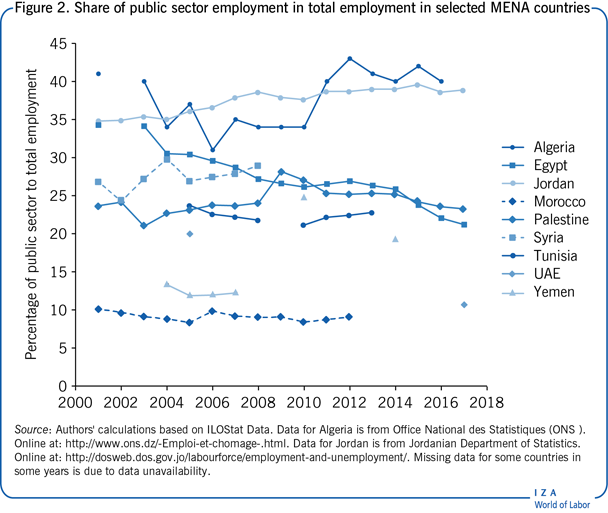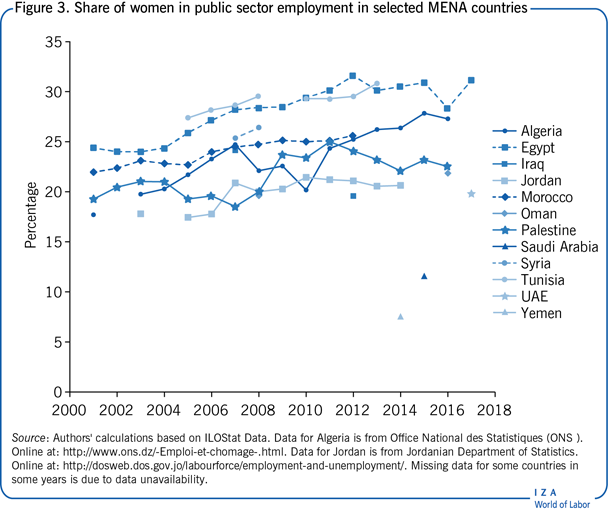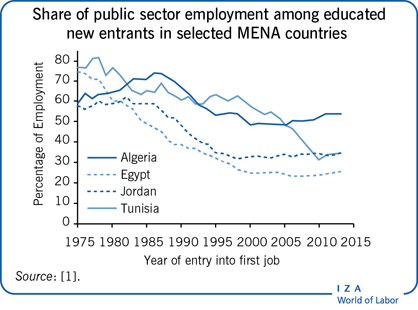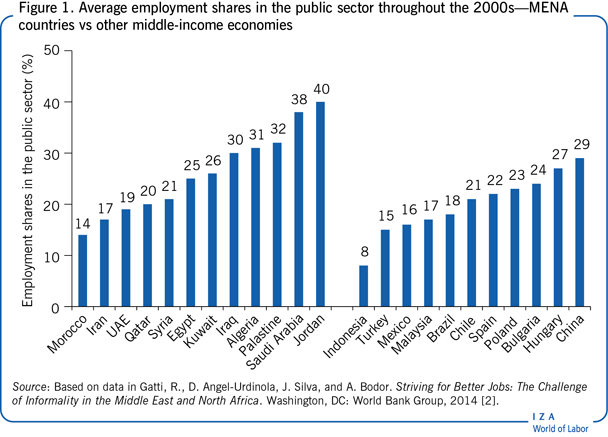Elevator pitch
Public sector hiring has been an essential component of the social bargains that have maintained political stability in the Middle East and North Africa (MENA). As these bargains eroded, public sector workforces contracted in relative terms owing to a partial freeze on hiring and the promise of lifetime job security for incumbent workers. This had profound effects on the age composition of the workforce. The upcoming retirement of many workers provides an opportunity to restructure public sector hiring to emphasize meritocratic recruitment processes and performance-based compensation systems.
Key findings
Pros
Slowed hiring and an aging workforce in the public sector offer an opportunity to carry out necessary civil service reforms.
Increased access to education for women has resulted in an increasing feminization of public sector workforces in the MENA region.
The erosion of social contracts linking public sector hiring to political stability provides an opportunity to transition to more meritocratic hiring practices.
Civil service hiring reforms have the potential to improve the quality of public administration and service delivery.
Cons
Public sectors in the MENA region remain large, which leads to deleterious effects on both budgetary sustainability and administrative efficiency.
The slowdown in hiring within the public sector contributed to high rates of educated youth unemployment, particularly among young women.
Political pressures post-2011 to address youth unemployment have led some policymakers to resume inefficient public sector hiring to placate politically sensitive groups.
Author's main message
The gradual downsizing of public sectors across the MENA region and the associated aging of public sector workforces provides an opportunity to restructure public sector hiring and compensation practices in a more meritocratic direction. However, as the downsizing continues, women, who are disproportionately dependent on public sector employment will be adversely affected in a context with already low female labor force participation. Therefore, innovative policies are needed to support women's employment in the private sector to compensate for the loss of opportunities in the public sector.
Motivation
The dynamics of public sector hiring are important to study as they have major implications for the performance of public administration, good governance practices, and the quality of public services. Moreover, public sector hiring practices have a significant impact on the efficiency of the overall allocation of human resources in a given economy. The extent of public sector hiring, the qualifications of those hired and the compensation practices of the public sector not only determine how efficiently human capital is deployed in the economy, but also affect the type of human capital that is produced. For instance, by emphasizing credentials rather than skills, public sector hiring practices encourage the over-production of certain credentials that may have little use in the private sector.
Public sectors have traditionally been key employers in theMiddle East and North Africa (MENA)region, even more so than in most other parts of the world. This role has in large part been driven by political agendas, as a means of upholding so-called social bargains with the general populace. However, as these bargains have gradually eroded in importance, a new opportunity presents itself to remake the public sector in countries across the region. In particular, the aging of public sector workforces presents an opportunity to restructure through early retirement schemes and a re-orientation of hiring practices in a more meritocratic direction.
Discussion of pros and cons
MENA region public sectors are large relative to those in comparable countries
The MENA region has some of the largest public sectors in the world. As shown in Figure 1, the average share of public sector jobs in total employment in the 2000s was 25% in Egypt, 31% in Algeria, and as high as 40% in Jordan [2]. This compares to just 8% in Indonesia, 15% in Turkey, and 17% in Malaysia. These shares are high even compared to China, which has a particularly large share of public sector employment at 29%. In the oil-rich Gulf Cooperation Council (GCC) countries, the public sector is the main employer of nationals, accounting for 87% of employed nationals in Qatar; 86% in Kuwait, and 72% in Saudi Arabia [3].
Historically, the provision of public sector employment has been a central component of the dominant social contract in the region, which has come to be known as the “authoritarian bargain” [4]. Authoritarian regimes provided public sector jobs and access to subsidized services and commodities in return for their political quiescence [5], [6]. In some countries, like Egypt and Tunisia, these guaranteed and socially protected lifetime jobs went to those who achieved a minimum level of education, in others, like Jordan, they went to members of Bedouin tribes and other groups critical to the political survival of the regime, and yet in others, like the GCC states, they went to all nationals.
By resulting in overstaffing and poor incentives for good performance, the expansion of public sector employment for political purposes often came at the expense of its budgetary sustainability and administrative efficiency. It also resulted in a segmented labor market, where total compensation in the public sector was higher than the market clearing level, leading to queuing behavior and high levels of unemployment among first time entrants eligible for public sector jobs [6]. Finally, the large public sector wage bill threatened fiscal stability and budgetary sustainability leading to calls for downsizing and retrenchment. The timing of these calls varied according to a country's economic performance. In Egypt, for example, public sector hiring began to stall in the 1970s due to such pressures.
The public sector share in hiring new entrants is declining
In addition to the growing fiscal burden of an over-sized public sector and the adoption of structural adjustment policies, evolving trends in demographics and educational attainment made it virtually impossible for MENA governments to maintain their side of the “authoritarian bargain” with respect to public sector hiring. Over the past two decades, the region has witnessed an acute version of what is commonly termed a “youth bulge,” a demographic phenomenon driven by falling early childhood mortality and the slow onset of declining fertility [7]. The youth bulge phenomenon was compounded by an increasing share of the population with upper-secondary education and above, the group that is typically eligible for public sector jobs. Starting from a low human development base in the 1980s, the MENA region has achieved near universal enrollment in primary education, an average enrollment of over 70% in secondary education, and close to 30% in tertiary education for both men and women [8]. This increased educational attainment has led to a rapidly growing pool of candidates for public sector jobs and the inability of public sectors around the region to maintain their high ratios of employment among secondary school leavers.
As shown in the illustration on page 1, the share of the public sector among jobs obtained by educated new entrants into the labor force has fallen steadily in many MENA countries. For example, in Egypt and Tunisia this share fell from a high of 75–80% in the mid-1970s to around 25–35% in the 2010s. The decline started somewhat later in Algeria and Jordan and was not as steep in Algeria due to its continued access to oil and gas revenues which finance its expansive public sector. All four countries appear to have experienced a slight increase in the share of public sector employment among educated new entrants just before or around the onset of the Arab Spring uprisings in 2011.
The reduced rates of public sector hiring among new entrants eventually resulted in falling rates of public sector employment overall in most MENA economies. As shown in Figure 2, the decline was most pronounced in Egypt, where the public sector share of employment fell from 35% in the early 2000s to 21% in 2017. While most other countries experienced slower declines, several, such as Algeria, Jordan, Morocco, and the United Arab Emirates (UAE) have since increased their public sector share of employment after the onset of the Arab Spring uprisings, thereby confirming the political nature of public sector hiring in the region. Data show a surge in hiring not only in countries that witnessed political unrest, but even more so among their neighbors, who feared the contagion effect of dissent. This is seen by comparing the size of public sector employment in 2011 and 2012, which jumped from 6.1 to 6.3 million workers in Egypt; from 0.9 million to 1.1 million in Algeria, from 696,000 to 725,000 in Tunisia; from 916,000 to 956,000 in Morocco; and from 550,000 to 568,000 in Jordan (ILOStat Data and ONS Algeria). Public sectors in oil-rich countries, which already accounted for large shares of employment among nationals, proceeded to offer their employees generous packages in response to the political tensions in the region. For example, Qatar and the UAE announced pay increases of between 50% and 120% in 2011. Even less affluent countries, like Egypt, Morocco, and Jordan took a similar course of action, albeit at lower levels [9].

The reductions in the relative size of the public sector in most MENA countries resulted from a slowdown in hiring of new workers rather than through large-scale dismissals or retrenchment of existing workers. This affected the demographic structure of the public sector, leading to substantial aging of the workforce in some countries. Egypt, which has experienced the most substantial decline, saw the proportion of workers in the public sector above the age of 45 increase from 40% in 2000 to 53% in 2014. Similarly, the share of those aged 45 and older increased from 26% in 2001 to 34% in 2010 in Algeria and from 34% in 2005 to 38% in 2013 in Tunisia. By contrast, in countries where the decline in the public sector share was more modest, the share of those aged 45 and older increased only slightly (e.g. in Jordan, from 14.1% in 2003 to 14.8% in 2014). However, it should also be kept in mind that Jordan, with its volunteer armed forces, includes as public sector employees members of the armed forces, who tend to be younger on average. Other countries, like Egypt, that rely on compulsory enlistment, do not include personnel of armed forces in household labor surveys. Hence, among Jordanian female public sector workers, who are not likely to be in the armed forces, the proportion of those aged 45 and older increased from 10.5% in 2003 to 15.7% in 2014.
Public sectors are increasingly feminized
In addition to their aging demographic makeup, public sector workforces in the MENA region tend to be increasingly feminized. Starting from a low base, women's increased access to secondary and tertiary education has been a key factor in this development. As shown in Figure 3, the share of women in public sector employment has tended to increase over time in all MENA countries, with the possible exception of Iraq. For example, the share of women increased from 25% in 2001 to over 31% in 2017 in Egypt, from 20% in 2001 to 27% in 2016 in Algeria, from 17% in 2005 to 21% in 2014 in Jordan, and from 22% in 2001 to 26% in 2012 in Morocco. In Palestine, meanwhile, the share grew from 19% in 2001 to 25% in 2011, only to fall back to 23% by 2017. These increases were considerably higher than the growth in the share of women in overall employment during the same period, indicating that women have been disproportionately seeking public sector jobs.

The feminization of the public sector workforce is driven in part by the closing of the gender gap in education and the subsequent growing share of women with secondary and tertiary education in the region. In fact, women now outnumber men among those pursuing university degrees, with the ratio of female to male tertiary enrollment across the MENA region at 1.08. In some countries, the ratio is far more favorable to women, such as in Qatar (1.76) and Tunisia (1.59) [8]. The increased access among women to tertiary education created a larger pool of potential candidates for public sector jobs, as most public sector hiring in the region is based on achieving certain educational credentials. Additionally, women strongly prefer public sector over private sector employment. This is partly due to the fact that the public sector provides workplaces that are more hospitable to women, including some that are separated by gender in some GCC countries. The public sector also offers favorable working conditions such as relatively short working hours, job security and stability, and social and health benefits, all of which are particularly valued by educated female workers [10]. Although these job characteristics apply to both men and women, within the prevailing culture that gives primacy to women's domestic roles and responsibilities, these public sector traits are even more strongly preferred among women [11]. In fact, data tracking women's employment before and after marriage show that women in private wage employment typically leave such employment after marriage, whereas their public sector employment is hardly affected by marriage [12]. It is also well established that while women are paid equally to similarly qualified men in the public sector, they are paid almost half as much in private sector employment [13].
Although public sector workforces have become more feminized, women's overall employment opportunities have been adversely affected by the contraction of public sector hiring. Female labor force participation rates in the MENA region are the lowest in the world and are rising very slowly, despite the aforementioned rapid gains in women's education. This disconnect between stagnant participation rates and rising educational attainment has been dubbed the “MENA paradox” [1], [8]. Moreover, a substantial portion of women's participation takes the form of unemployment, particularly among young educated new entrants who are queuing for public sector jobs. Unlike men, who must often fall back on low-quality jobs in the informal economy, unemployed young women often exit the workforce altogether rather than take jobs in the informal economy. Informal jobs, such as domestic service or work in small retail establishments, are widely perceived as threatening to women's sexual safety and reputation and incompatible with gender norms that define women's primary role as that of homemaker [11].
The region as a whole, therefore, is in urgent need of policies to address its high rate of female unemployment and limited labor force participation. Policies should include women-focused active labor market programs, reforms in social services such as public transportation and childcare support, and state-supported programs that reward and encourage work, including pay supplements and reduced social insurance contributions.
Private sectors are unable to compensate for public sectors’ declining hiring share
The expansion of public sectors in the region may have come at the expense of crowding out private sector growth, but the subsequent withdrawal of the public sector from the economy has not necessarily resulted in growing and dynamic private sectors. A study from 2013 shows that MENA private sectors have among the world's highest average firm age, with the majority of firms starting small and staying small. The regulatory environments in most MENA countries often contribute to a high cost of formality, pushing many businesses into informality. Certain markets are also protected or monopolized by the state, allowing only a few privileged insiders to participate. In the World Bank's ease of business ranking, the UAE is the only MENA country that appears among the top countries (ranked 11 in 2019). Among other region countries, it was followed by Morocco and Bahrain (ranked 60 and 62, respectively). Egypt, the largest country in the region, ranked 120.
The general complexity of doing business in the region contributes to increased informality, both at the enterprise and job levels. At the firm level, registration complexity and high cost inhibit formalization, confining small businesses to the realm of informality. Informal employment, either in formal or informal enterprises, leads to loss of access to benefits and social protection. Data on active contributors to old-age pension schemes is a good proxy measure for informality.
Active contributors to pension schemes range from 2.8% of the working-age population in Oman to 29.0% in Egypt, and access to contributory schemes correlates strongly to the data on the share of public sector employment in labor markets in the region. In fact, the size of the public sector is clearly a predictor of access to contributory schemes. With small and anemic formal private sectors, the oversized public sector constitutes the dominant component of formal employment in the economy. The remaining employment is mostly in the informal economy and is thus characterized by weak social protection and no social insurance coverage [6].
Private sectors in the region are not compensating for the loss of jobs in the public sector, which intensifies populist demands for more public sector jobs. Supporting the growth of the private sector by improving the business climate and reducing the costs of formality would ultimately ensure a transition of social contracts in the region, from a reliance on public sector hiring as a tool for political favors, to one of shared prosperity based on a dynamic private sector.
Limitations and gaps
A key limitation when attempting to propose appropriate reforms in public sector hiring in MENA is the lack of information on public sector hiring and compensation practices, including the number of qualifications of recruits, the selection processes used, and the process by which compensation and benefits are determined.
Another major limitation is spotty data availability across many countries in the MENA region on the composition of the public sector workforce. For countries where no micro-data is available, this article relies on published figures by the International Labor Organization (ILOSTAT), which often lacks the necessary details or is outright missing for many countries. Greater access to micro-data would allow more detailed analyses of the changing demographics of public sector workforces over time.
Summary and policy advice
Public sector hiring is declining in the MENA region as social contracts that have traditionally offered public sector jobs in exchange for the political quiescence of critical constituencies erode. Because incumbent workers were protected as public sectors contracted, considerable aging has occurred within the public sector workforces in many countries. The imminent retirement of large numbers of workers, possibly aided by some early retirement schemes, provides an opportunity for a major restructuring of hiring processes in a more meritocratic direction.
This approach would capitalize on the already highly attractive nature of public sector jobs to substantially upgrade the quality of recruits. This is also an opportunity to institute civil service reforms that more directly tie compensation to performance as a way to upgrade the quality of public services.
Because women are more dependent on public employment, the decline in public sector hiring affects them disproportionately. There is therefore a need to facilitate greater access for women in the private sector through reforms in social services, such as public transportation and childcare, and other state-supported programs that make it possible for women to continue working in the private sector after marriage.
Acknowledgments
The authors thank anonymous referees and the IZA World of Labor editors for many helpful suggestions on earlier drafts. Previous work of the authors contains a larger number of background references for the material presented here and has been used intensively in all major parts of this article [1], [6], [7], [10], [11], [12].
Competing interests
The IZA World of Labor project is committed to the IZA Code of Conduct. The authors declare to have observed the principles outlined in the code.
© Ragui Assaad and Ghada Barsoum

